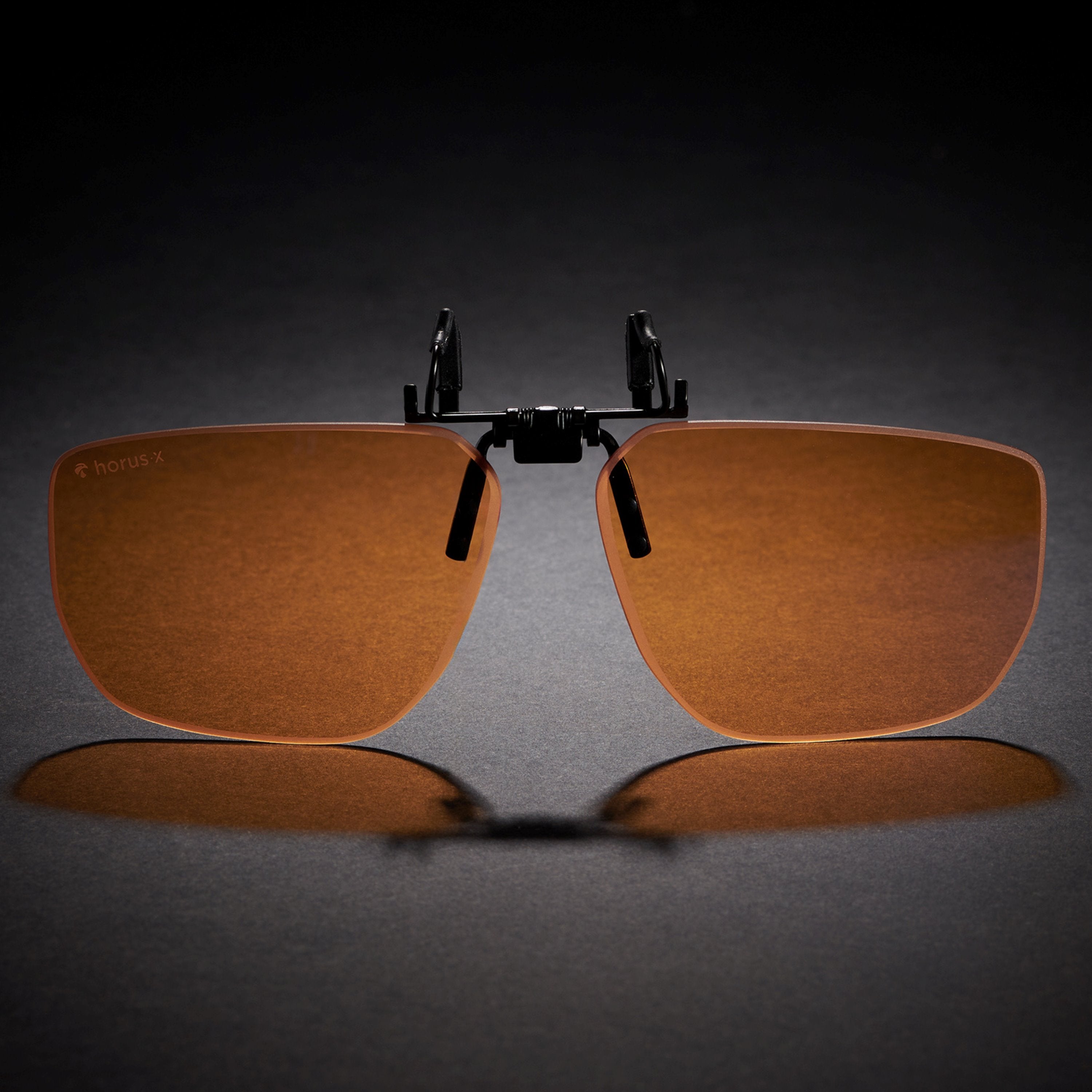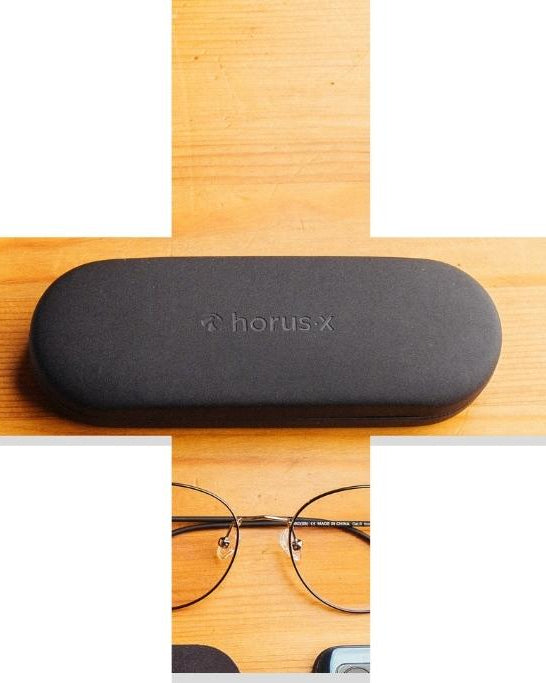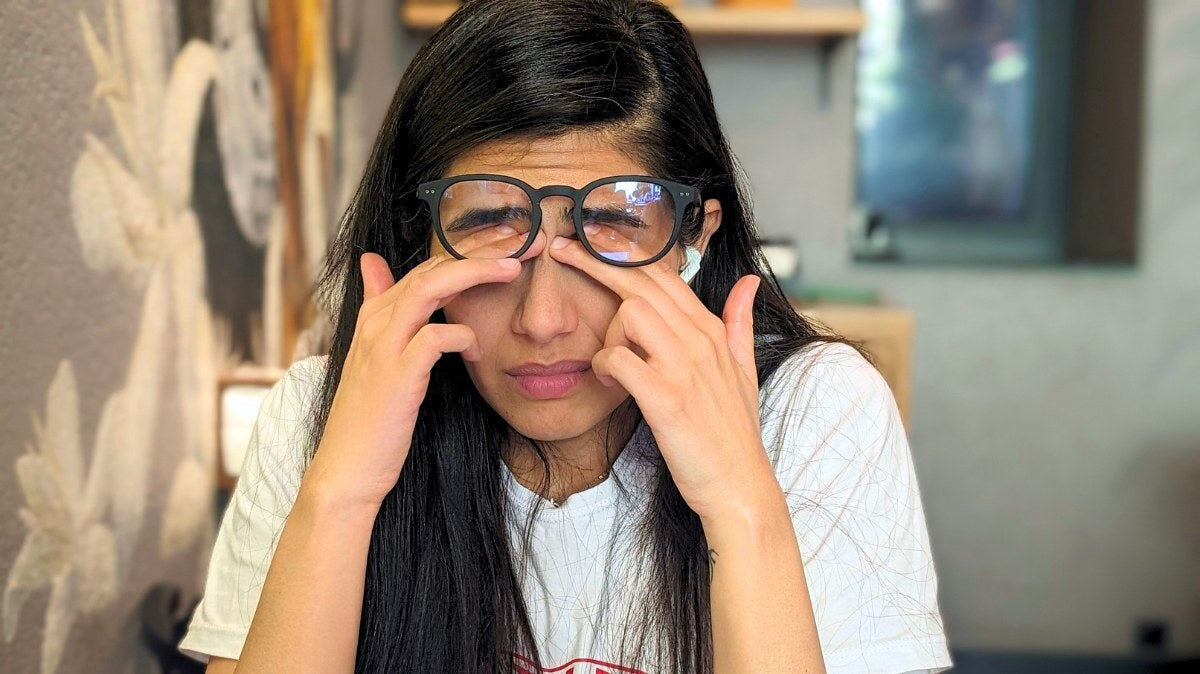What's the connection between blurred vision and neck pain?
We know the answer and even have helpful tips on how to keep both your eyes and the cervical spine in tip-top shape!
So, if you've been wondering why your neck pain might be blurring your vision, or vice versa, this article has you covered.
A bit of anatomy
What is the cervical spine?
Your neck is made up of 7 vertebrae reaching from the nape of your neck to your skull. This area is known as the cervical spine.
The vertebrae in your cervical spine are stacked on top of each other, linked together by tendons and ligaments, and separated by intervertebral discs.
👉 Their role, as well as that of the neck muscles, is to support the weight of your head and allow it to move. It's literally what keeps your head on your shoulders, or almost!

A reminder about your eyes
You may not know it, but each of your eyes is surrounded by blood vessels and muscles. The blood vessels provide oxygen and nutrients to your eyes to keep it healthy, and the muscles help facilitate their mobility.
You can thank the 4 rectus muscles and 2 oblique muscles per eye for your ill-fated attempts at winking at strangers - even if it doesn't get you the results you were hoping for.
👉 Thanks to these so-called oculomotor eye muscles, you can look in all directions without having to make any special effort.
It might seem strange but your eyes and cervical spine are actually linked. That’s why it’s normal to experience both blurry vision and neck pain at the same time. And not just because you’ve been staring up at Dwayne Johnson for hours.
The link between the cervical spine, neck pain and blurred vision
Everything in the human body is connected (the hip bones connected to the… thigh bone 🎶) and works together to an almost scary degree.
We’re all just walking, talking meat sacks really.
Particularly in the case of the eyes and neck. The eye muscles and neck muscles are actually designed to work together to logically follow each other in terms of head position and mobility.
In fact, vision influences the position of your head and your neck; and the neck does the same in return. A perfect meat sack machine!
👀 ➡️ 🧠How your vision can impact your cerebral spine
Have you ever noticed that when you get blurred vision, you immediately adjust your posture to try and correct it? You’re doing it so subconsciously you might not have even noticed, but that’s your body trying to tell you one side will help the other.
You end up tilting your head more, bringing the weight forward to try and fix the situation but you’re actually unintentionally making it far worse.
Unfortunately, what you’re doing can not only worsen your eye ailments but also cause neck pain.

Vision disorders, when left untreated, cause poor posture, causing pain in the shoulders, neck and upper back. For example, people with ocular convergence disorders are more likely to suffer from neck pain.
And if you don’t have these problems, well… lucky you. But as the saying goes, prevention is better than cure.
If you’re reading this on a computer or smartphone, then I can almost guarantee you’ve experienced eye fatigue, also known as digital eye strain. Staring too long at screens can result in itchy, stinging or watery eyes and even blurred vision, thanks to the blue light they emit.
So even if you have no vision issues, blue light can still impact your eyes negatively on a daily basis, making it important you take preventative measures. Like wearing blue light blocking glasses when you’re in front of screens for long periods of time.
🧠 👀 ➡️ How posture impacts both the cervical spine and the eyes
Even if your eyes are in better shape than a sniper scope on COD, you can still suffer from blurred vision and neck pain thanks to poor posture. So, all that slumping around was worse than you thought.
How does poor posture cause blurred vision and neck pain?
When your posture is poor your eyes and the muscles of your neck and shoulders are overstretched. This means they undergo prolonged tension which leads to a higher risk of contractures and neck and back pain. Not ideal on its own, but it can also lead to migraines and blurred vision.
How to keep both your neck and eyes comfortable
If you want to avoid blurred vision and neck pain, there are a few small steps you can take to break your bad habits.
Adopt a better posture
- 🖥 Rather than slumping at your computer like you’ve just realised we have to wait 2 years for season 2 of The Last of Us, there are things you can do to improve your posture. Raise your monitors and other screens so that they’re at eye level. You can do this using screen supports that are specifically designed for laptops to correct and prevent posture problems.
- 🐭Also remember to similarly take into account the height of your keyboard and mouse.
- 💺A good quality seat is a must. You want it to be ergonomic and comfortable for long periods of time. You can also look into standing desks and other ways to improve your gaming set-up and posture simultaneously.
- 📲When on your cell phone, try and keep it at eye level so you’re not always looking down and running into people like a human bumper car.
- 🏃♀️Take good care of your neck, shoulders and back in general. That means actually exercising occasionally to strengthen those muscles.

If you’re really concerned and want to ensure you’re taking every possible step to prevent pain, you can always consult a professional. Depending no your needs, you may need to see a physiotherapist, an osteopath, a rheumatologist... Don't hesitate to ask your GP for advice.
Reduce screen time & protect yourself from blue light
As well as adopting a better posture, you can further prevent blurred vision and neck pain by simply spending less time staring at screens. Go outside and smell the roses… or pollution, depending on where you live.
Regular breaks from using screens can reduce dry eye, eye fatigue (also known as Computer Vision Syndrome) and neck pain.
- ⏳You might not have used it before, but there is a pause button on your game, we promise. See it as a challenge: How much can you achieve before you have to stop for 20 minutes? Can you finish that side quest in time?
We’ve mentioned blue light already, but it's an important subject here at Horus X and we want to spread awareness of the perils of blue light.
To avoid hurting your neck and eyes, blocking blue light when spending a long time on screens is essential.
The negative effects and dangers of blue light can be both short and long-term, resulting in issues like eye strain and age-related macular degeneration (AMD).
That’s why it's important to protect yourself by wearing anti-blue light blocking glasses, whenever possible, especially if you’re a gamer.
There are other steps you can take to reduce the potential for blurred vision and neck pain; including, staying well hydrated, having a balanced diet, and regularly consulting a specialist if you suffer from eye dryness.
💡If you frequently suffer from eye irritation and fatigue, eye massage can also be a simple and effective solution to help relieve pain and aches. Alternatively, you can check with your doctor about whether you suffer from dry eye and get eye drops that will help.
Blurred vision and neck pain: Final thoughts
Remember:
- Your eyes and muscles on your neck work together. This means to adjust your vision, you also adjust the position of your head. And while the information transmitted to your eyes goes to your brain first and foremost, it's also interpreted by your cervical spine.
- Vision has a direct influence on your cervical spine. If you suffer from blurred vision, you risk suffering from upper back pain.
- A bad posture has an impact on both your vision and neck, resulting in blurred vision and neck pain. This is particularly for you heavy computer or screen users. Remember—breaks are essential!
- Reduce screen time, protect yourself effectively against blue light, and improve your posture to prevent and lessen the effects of these things, so you don’t end up with blurred vision and neck pain.

















Comments
Excellent article que tous devraient lire
Efectivamente! Llevo 3 semanas haciéndome exámenes a los ojos y nada! Todo bien. Como me duele mucho el cuello, pensé en las cervicales. Visión borrosa y doble, dolor de cabeza, mareos y otros. Veré un traumatologo porque no lo veo hace mucho tiempo. Gracias por los consejos! Mala postura con el celular y falta de ejercicio.